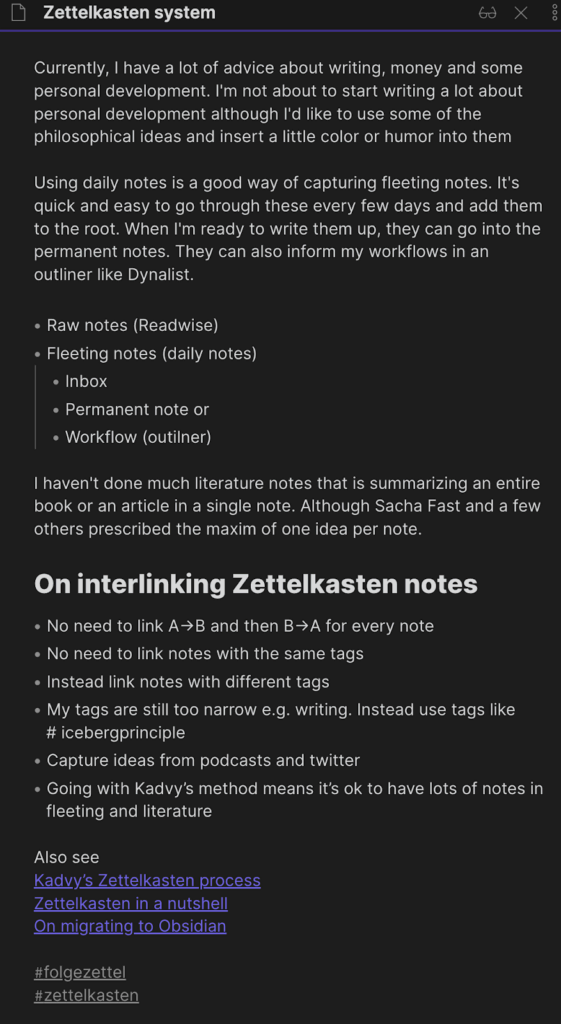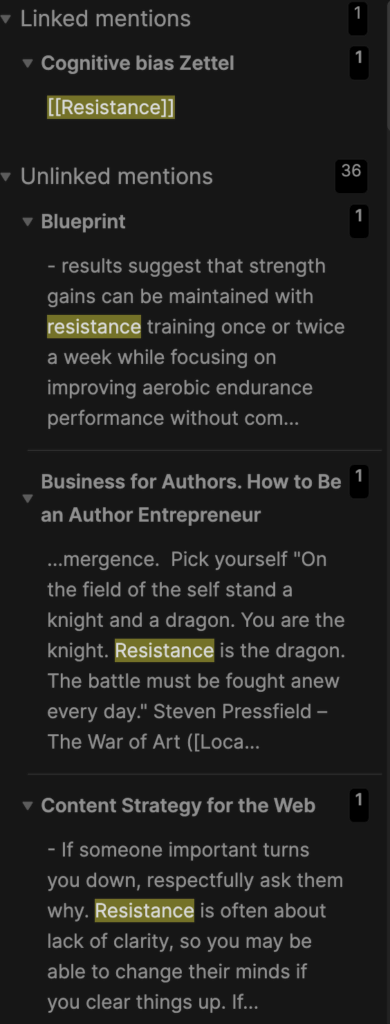Obsidian Review
Obsidian Review: The Bottom Line
Obsidian is a powerful note-taking app and a personal knowledge management system. Whether you need it depends on how seriously you take note-taking, writing, and research. Casual writers are probably fine with Apple Notes or text files. But it’s worth Obsidian is worth investing time in, if you take a lot of notes or write professionally. The main downside to Obsidian is the small learning curve. Understanding the basics of Markdown, interlinking notes and then navigating the plethora of options inside Obsidian may put off some new users. However, the app is fast and easy to use, once you get past this initial hurdle. Today, I couldn’t imagine capturing notes and writing without it.
Pros
- Free
- Fast
- Powerful bidirectional links
- Supported by a vibrant community of users
Cons
- Small learning curve
- Mobile app has some usability issues
In this Obsidian review, discover what this personal knowledge management software can do and if it’s worth using for your notes and wiki.
Obsidian is a powerful personal knowledge management tool. It’s built as a “second brain” and has a cult following online. I recently migrated all my personal notes into Obsidian, and I haven’t looked back. I use it almost every day for note-taking, writing and research.
This review will explain how I use Obsidian today and some of its critical features for writers, note-takers, and anyone interested in personal knowledge management.
Read our guide to the best personal knowledge management software.
If you want to set up your own note-taking system for your writing, I created just the thing. Click here to learn more.
Contents
What Is Obsidian?
Obsidian is a Markdown file reader. It sits on top of any relevant files in a designated folder or vault and enables users to write, edit and interlink their notes.
It’s built for taking notes quickly and adding bidirectional links. You can use it to build a personal wiki or Zettelkästen. It provides information about key themes and topics in each note so writers and note-takes can observe organic connections.
Shida Li and Erica Xu built and now maintain Obsidian. Li and Zu previously made the popular outlining app Dynalist. It’s also supported, via optional plugins, through an active community of users. To learn more about their work, read our Dynalist review
Who Is Obsidian Ideal For?
Obsidian is a powerful note-taking app and personal knowledge management too. Not everyone needs it. But it’s a good choice if you’re a:
- Professional writer
- Blogger
- Student
- Research
- Serious about personal knowledge management
Availability
Obsidian is available on Mac, Windows, iOS and Google Play, and Linux. It’s a relatively new knowledge-based software, so expect a few bugs depending on the platform. You might also be interested in our Resume Worded review.
Pricing
Obsidian is free to use. The lack of a monthly subscription for most users is refreshing.
Power users can support the project by purchasing Obsidian Sync or Obsidian Publish. The former costs $10 per month or $96 per year. The latter costs $20 per month or $192 per year.
You can use Obsidian Sync to sync encrypted notes across all Obsidian installs instead of relying on iCloud or other sync services.
Obsidian Sync is faster and snappier than iCloud. Obsidian Publish is helpful if you want to turn your notes into a website. I didn’t test this feature, although you can view a demo on the Obsidian website. You can also check out our GoTranscript review.
How I Use Obsidian
Over the years, I’ve tested many note-taking apps. At one point, I relied heavily on Evernote until it became somewhat bloated. Although Evernote is much faster today, I moved many of my personal notes into Apple Notes and Day One. (I still use Evernote for storing PDFs and some source material.) However, neither tool is ideal for building a personal wiki or Zettelkästen.
I recently explored some tools for managing my personal Zettelkästen or Slip box. I tested several options, including Bear and Roam Research, but I selected Obsidian as I can maintain complete control over my notes.
They sit in a secure folder on my computer. I write and edit these notes using the Obsidian app for iOS and Mac. I can also open and edit these notes with another Markdown writing app like Ulysses. In other words, it’s easy for me to migrate or use another writing or note-taking app. That’s not possible if my notes are locked into a proprietary tool like Roam Research, Bear or Evernote, as helpful as these tools are.
Read my Ulysses review
I migrated three thousand-plus notes into Obsidian. Today, I use Obsidian to capture notes and ideas for books I read, courses I take and podcasts I listen to. I review my notes inside of Obsidian regularly, summarise learnings in my own words and interlink them. Then, I refer to these notes when writing an article about a particular topic. In short, I use Obsidian as a research tool or for building and maintaining my personal Zettelkästen.
Learn more about the Zettelkästen Method
Is Obsidian Good for Note-taking?
Capturing notes and ideas in Obisidian is quick and easy. Simply open up the app, create a new note and start typing.
While writing, users can open up multiple vertical or horizontal windows. That way, they can work on one note while referring to another. The Live Preview mode shows what a Markdown-formatted note will look like when published. It supports Markdown, meaning you can easily format a note for publication.

Obsidian excels at creating bidirectional links. Simply, type [[ and Obsidian searches your database or vault and presents suggestions. This type of internal contextual linking dramatically speeds up building personal knowledge or Zettelkästen.
The collapsable right-hand sidebar reveals linked and unlinked mentions for the note. Linked mentions refers to other notes with a backlink to the note in question. Unlinked mentions refer to notes using the same keywords but without a backlink. I use this feature a lot to explore connections emerging between my notes and ideas.

If you’re visual thinking, the Open Graph View presents a knowledge graph of all notes inside of Obsidian and shows how they link together. It’s useful if you want to explore related themes and notes. Obsidian also enables users to sort notes by hashtags.

You can accomplish most of the above on the apps for a tablet and mobile. However, searching and interacting with a large database of notes is best kept for the desktop version.
Obsidian is also insanely keyboard friendly. If you take the time to learn the shortcuts or create your own, you can navigate many of its key features using a keyboard, speeding up the process of taking notes.
Read our guide to the best note-taking apps
Obsidian Customization and Plugins Options
Obsidian has a distinctive look and feel. It’s a black and white note-taking app. If you dislike the default theme or style, it’s possible to change it from dark mode or install other themes built by the community. You can also set keyboard shortcuts, change color schemes and more.
An enthusiastic community maintains Obsidian, many of who migrated from premium note-taking apps like Roam Research. The community has built a variety of plugins and tools users can install to customise the look and feel of Obsidian.
For example, the popular Admonition plugin changes the look and feel of notes inside the app. You can also use some of these plugins to create Kanban Boards, To-Do lists and more… and turn Obsidian into productivity software.
I installed the Daily Notes plugin, built by the official team. This plugin creates a new note time-stamped with today’s date when I open Obsidian. I capture fleeting notes here and then review these notes once a week.

Obsidian Sync
Many note-takers and writers worry about losing their work. Obsidian syncs notes between devices using iCloud, Dropbox, OneDrive, Syncthing and Obsidian Sync. You can pick up from where you left off only any device.
If you’ve thousands of notes, it’s worth paying for Obsidian Sync as it handles syncing more efficiently than other options. I didn’t enter any sync issues apart with the exception of the daily note plugin. Opening up a daily note on multiple devices on the same day can cause some sync issues as one daily note will overwrite another, but this is an edge use case.
FAQ About Obsidian Review
Is Obsidian software Safe?
Obsidian is safe to use. You maintain full control of your notes and can even encrypt your vault.
Is Obsidian better than Roam?
Obsidian and Roam Research several different audiences. Both are good tools. Those who value 100% control over their notes and dislike monthly fees should opt for Obsidian. Users who want more tools for networking notes may prefer Roam Research.
